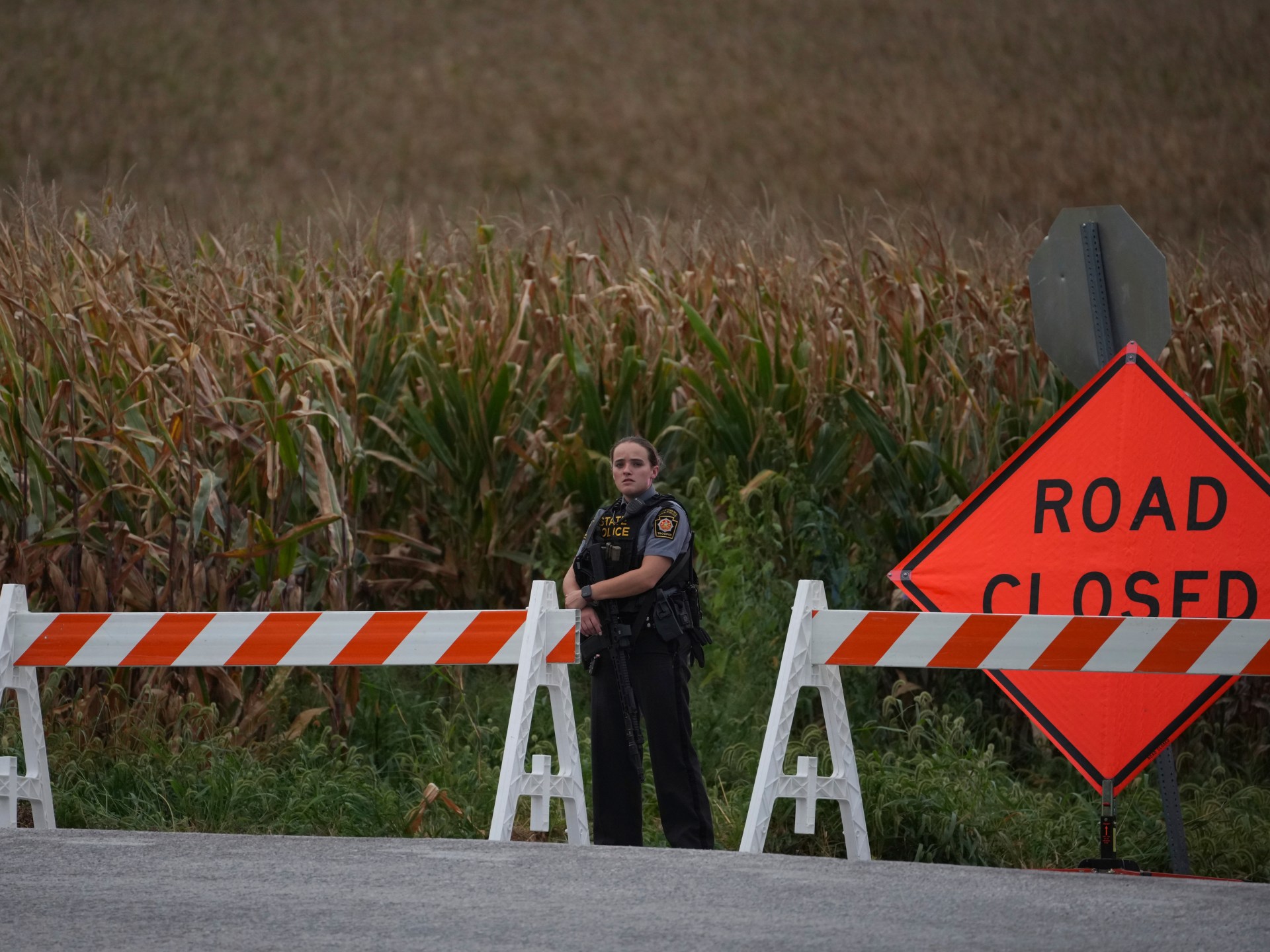
Bitcoin (BTC) Traders Buy More Downside Protection After Federal Reserve Rate Cut: Deribit CoinDesk
source

Saad is an engineer with more than a decade of experience in FMCG companies. He loves to write about innovative tech and blockchain.
XRP (Ripple) maintains crucial support at $3.00 while trading within a symmetrical triangle pattern. A successful breakout could push prices toward $3.40, with potential extension to $4.20 if buying momentum persists.
XRP (Ripple) finds itself at a decisive moment as it consolidates within a symmetrical triangle formation. The digital asset's ability to hold above the $3.00 threshold suggests an impending breakout is on the horizon. The direction of this move—whether toward $4.20 or back to lower support levels – will largely depend on bulls' capacity to defend this crucial price zone.
The current chart pattern displays a textbook symmetrical triangle, a technical formation that typically precedes significant price movements. Based on analysis from EGRAG CRYPTO, XRP remains positioned for upside momentum provided it avoids closing below the $3.00 mark.
The $3.00 level serves as the critical “retest edge” where buyers need to step in.
While temporary dips to the $2.90–$2.95 range remain possible without invalidating the bullish structure, sustained weakness below $3.00 would shift focus to downside targets at $2.80, $2.55, or potentially $2.00. On the upside, initial resistance sits at $3.30–$3.40, with $4.20 representing the primary breakout objective.
The 21 EMA and 33 SMA are converging beneath the current price action, which reinforces $3.00 as a robust support foundation. Volume has been declining during this consolidation phase, which is typical behavior, though historical patterns suggest a breakout could spark renewed trading activity. The dotted projection lines mapped in earlier analysis align remarkably well with current price development, validating the symmetrical nature of this formation.
XRP's technical setup emerges against a backdrop of evolving macro conditions including a softer U.S. dollar, improved risk sentiment, and resilient cryptocurrency markets overall. Growing institutional interest could provide the fundamental catalyst needed to complement the technical breakout scenario.
XRP's next significant move hinges on how this triangle resolves itself. A bullish outcome would see prices hold above $3.00 and break through $3.40, potentially triggering an advance toward $4.20. Conversely, a bearish resolution involving a close below $3.00 would open the path to $2.80 or lower levels. For now, the $3.00 level remains the critical battleground. As long as buyers can defend this zone, XRP appears primed for increased volatility that could establish its next major trend direction.
Saad is an engineer with more than a decade of experience in FMCG companies. He loves to write about innovative tech and blockchain.
Disclaimer: TheTradable content is for informational purposes only. The website does not provide any financial advisory. We do not encourage trading any assets. Any trading activity should be done at a user’s own risk. We encourage all users to rely solely on their own due diligence when making any financial decisions.
TheTradable is a Financial News Website, focusing on the global Tradables Market. TheTradable is based in Tbilisi (0179, Georgia, Tbilisi City, Vake District, 49 Besarion Zhghenti Street, VAT 305786600).
© 2020-2025 thetradable.com
We use cookies to improve your experience on our site and to show you relevant advertising. To find our more, read our privacy policy and cookie policy

Three officers were killed, while two others are in critical but stable condition, in one of the deadliest recent attacks on the US police.
By Elizabeth Melimopoulos
Share
Save
Three police officers were shot dead and two wounded on Wednesday in southern Pennsylvania in the United States before the attacker was shot down, authorities said.
It was one of the deadliest days for police, not only in Pennsylvania, but in the US, in recent times.
Here is what we know:
The shooting happened a little after 2pm (18:00 GMT) on Wednesday at a farmhouse along a quiet country road, a few miles outside an old mill town.
Five police detectives and a deputy sheriff had gone there to arrest a man on suspicion of stalking, prowling and trespassing, District Attorney Tim Barker said.
According to Barker, the suspect, Matthew Ruth, opened fire on the officers with an AR-15-style rifle. The four detectives closest to him were hit, and two managed to stagger into cover as they returned fire.
The gunman then turned on the fifth detective and the deputy as they joined the gunfight. The exchange ended with three detectives and the suspect dead, authorities said. The fourth detective and the deputy were critically wounded.
The emergency response unfolded on the rural road. Officers held people back from the area as about 30 police vehicles blocked off nearby streets.
The shooting took place on Haar Road in North Codorus Township, a farming community in York County.
It is about 185km (115 miles) west of Philadelphia, not far from the Maryland border, authorities said.
The shooting also prompted a temporary shelter-in-place order for a school district in Spring Grove, Pennsylvania, a town of roughly 2,500 residents. Officials later clarified that no schools were affected.
The gunman was identified as 24-year-old Matthew Ruth. Barker said the farmhouse belonged to Ruth’s ex-girlfriend and her mother.
The night before the incident, the two women told officers that Ruth had been hiding outside their home in camouflage and looking through the windows with binoculars.
The ex-girlfriend also suspected him of torching her pick-up truck last month.
Police obtained an arrest warrant after failing to find him during an overnight search. When detectives and a deputy sheriff returned to the farmhouse the next afternoon, they came under immediate fire.
Authorities have not provided many details about the victims.
Two surviving officers were transported to WellSpan York Hospital in York, Pennsylvania, and were currently in critical but stable condition, Paris said.
Images from the scene showed an officer being airlifted by a medical helicopter.
“This is an absolutely tragic and devastating day for York County and the entire commonwealth of Pennsylvania,” Pennsylvania Governor Josh Shapiro said during a news briefing.
“We grieve the loss of life of three precious souls who served this county, who served this commonwealth, who served this country.
“This kind of violence is not OK. We need to do better as a society,” Shapiro said.
This marked one of the darkest days for Pennsylvania law enforcement in recent years. Back in 2009, three Pittsburgh officers were shot dead in an ambush while responding to a domestic disturbance by a man wearing a bulletproof vest.
More recently, in February, another officer in the state was killed after a man armed with a pistol and zip ties stormed a hospital’s intensive care unit, taking staff hostage before a shootout left both the suspect and the officer dead.
Nationally, the killings are also among the deadliest single incidents for police officers since the September 11, 2001 attacks. In April this year, four officers were killed in Charlotte, North Carolina; three were killed in Baton Rouge, Louisiana; five in Dallas, Texas, in separate incidents in July 2016; four were killed in Lakewood, Washington, in November 2009; and four in Oakland, California, in March 2009.
Shapiro ordered all US and Pennsylvania flags on public buildings across the state to be lowered to half-staff in memory of the officers killed in the Wednesday attacks.
Follow Al Jazeera English:

For years, XRP was one of the most controversial names in crypto. The token spent much of its recent history under the shadow of the U.S. Securities and Exchange Commission (SEC), facing lawsuits and uncertainty that made many investors cautious. Fast-forward to 2025, and the story looks very different. XRP has gone from a coin fighting for its survival to becoming a serious player in the growing world of tokenized finance. The shift is not the result of hype or celebrity tweets. Instead, it comes from partnerships with some of the largest financial institutions in the world. Ripple, the company behind XRP’s technology, is now working directly with Wall Street-level players, showing that its blockchain is ready to serve institutional needs.
The announcement that made waves came when Ripple revealed collaborations with Singapore’s banking leader DBS and asset management heavyweight Franklin Templeton. Together, these organizations are building new financial products on the XRP Ledger (XRPL). Franklin Templeton has introduced sgBENJI, a tokenized version of a U.S. dollar money market fund. Instead of being stored in traditional systems, sgBENJI lives on the XRP Ledger, taking advantage of its speed and efficiency. At the same time, DBS’s Digital Exchange will begin supporting Ripple’s own stablecoin, RLUSD, which will be tradable and usable for lending by accredited investors.
This combination gives institutions new ways to move money and assets, creating faster, cheaper, and more flexible alternatives to traditional finance. Tokenized funds can even be used as collateral in lending markets, something that could one day transform how large sums of money flow across borders. Money market funds are usually considered safe, steady investments, and stablecoins are designed to hold value against currencies like the U.S. dollar. By combining these two ideas on the blockchain, Ripple and its partners are creating a bridge between traditional finance and digital assets.
The XRP Ledger is the technology behind it all, acting as the infrastructure that processes transactions. While XRP itself is not the direct focus of these partnerships, the fact that institutions are building on its network increases its long-term value. More usage of the ledger means more potential demand for XRP to power transactions and act as a bridge currency.
Only a few years ago, XRP was often seen as risky because of its ongoing legal issues with the SEC. Being labeled a security and facing penalties damaged its image and kept some investors away. Today, the picture looks very different. Instead of being viewed as a liability, XRP’s ecosystem is attracting some of the world’s most trusted financial names. For many in the crypto community, this feels like a turning point. XRP is no longer just a token trying to prove it belongs in the market; it is now part of large-scale projects with major banks and asset managers.
Ripple’s move is about more than XRP’s price. Tokenization of funds and stablecoins could reshape global finance by making markets more efficient. Instead of waiting days for transactions to settle, assets can move instantly on blockchain rails. For institutions, this reduces costs and increases flexibility. If successful, this could encourage even larger asset managers, such as BlackRock or Fidelity, to explore similar opportunities. That would bring trillions of dollars’ worth of assets closer to blockchain ecosystems like XRPL.
In the short term, many analysts expect XRP’s price to test higher levels as momentum builds. Some predictions suggest a move toward $4 in the coming months, with $5 as a possible year-end target if adoption grows. Longer term, the focus will be on whether tokenized markets scale successfully and whether Ripple’s RLUSD stablecoin gains traction. Challenges remain, including regulatory oversight of stablecoins, potential volatility in broader crypto markets, and the performance of the first products being launched. Still, the direction is clear, XRP is becoming part of the conversation around the future of institutional finance.
From courtroom battles to partnerships with some of the world’s biggest financial players, XRP has undergone a dramatic transformation. The integration of tokenized money market funds and stablecoins on its ledger shows how far the ecosystem has come. While retail investors may need to wait for broader access, the groundwork being laid could mark the beginning of a new era for both XRP and blockchain finance as a whole.
Stay informed with daily updates from Blockchain Magazine on Google News. Click here to follow us and mark as favorite: [Blockchain Magazine on Google News].
Disclaimer: Any post shared by a third-party agency are sponsored and Blockchain Magazine has no views on any such posts. The views and opinions expressed in this post are those of the clients and do not necessarily reflect the official policy or position of Blockchain Magazine. The information provided in this post is for informational purposes only and should not be considered as financial, investment, or professional advice. Blockchain Magazine does not endorse or promote any specific products, services, or companies mentioned in this posts. Readers are encouraged to conduct their own research and consult with a qualified professional before making any financial decisions.
Blockchain Magazine is a leading global platform covering Web3, DeFi, NFTs, and blockchain trends—empowering innovation through news, insights, interviews, and expert-driven content.
About
About
Editorial Team
Careers
BM Press
Get in touch
Contact Us
Advertise
Sitemap
Author Program
Fine Print
Editorial Policy
Privacy Policy
Ethics Policy
Terms of Use
Important Links
About
About
Editorial Team
Careers
BM Press
Get in touch
Contact Us
Advertise
Sitemap
Author Program
Fine Print
Editorial Policy
Privacy Policy
Ethics Policy
Terms of Use
Important Links
© 2015 – 2025 Blockchain Magazine Now in USA | Singapore | India • All Rights Reserved.
Looking to expand your reach in the blockchain industry? Advertise with Blockchain Magazine and connect with a highly engaged global audience.
📧 Reach us at: [email protected]
💬 Or DM us on Telegram: @bcm_media
For more information on our audience demographics, statistics, and advertising opportunities, visit our detailed Advertise page.
Press “ESC” key to close
Stay ahead of the curve with expert analysis, market updates, and exclusive content curated by our team of blockchain enthusiasts.

The California Lottery offers multiple draw games for those aiming to win big. Here’s a look at Sept. 18, 2025, results for each game:
Midday: 2-8-3
Evening: 5-2-1
Check Daily 3 payouts and previous drawings here.
1st:6 Whirl Win-2nd:9 Winning Spirit-3rd:8 Gorgeous George, Race Time: 1:47.81
Check Daily Derby payouts and previous drawings here.
03-08-27-29-32
Check Fantasy 5 payouts and previous drawings here.
3-6-9-0
Check Daily 4 payouts and previous drawings here.
Feeling lucky? Explore the latest lottery news & results
This results page was generated automatically using information from TinBu and a template written and reviewed by a Desert Sun producer. You can send feedback using this form.
Gambling involves risk. Please only gamble with funds that you can comfortably afford to lose. While we do our utmost to offer good advice and information we cannot be held responsible for any loss that may be incurred as a result of gambling. We do our best to make sure all the information that we provide on this site is correct. However, from time to time mistakes will be made and we will not be held liable. Please check any stats or information if you are unsure how accurate they are. No guarantees are made with regards to results or financial gain. All forms of betting carry financial risk and it is up to the individual to make bets with or without the assistance of information provided on this site and we cannot be held responsible for any loss that may be incurred as a result of following the betting tips provided on this site. Past performances do not guarantee success in the future and betting odds fluctuate from one minute to the next. The material contained on this site is intended to inform, entertain and educate the reader and in no way represents an inducement to gamble legally or illegally or any sort of professional advice.
Gannett may earn revenue from sports betting operators for audience referrals to betting services. Sports betting operators have no influence over nor are any such revenues in any way dependent on or linked to the newsrooms or news coverage. Terms apply, see operator site for Terms and Conditions. If you or someone you know has a gambling problem, help is available. Call the National Council on Problem Gambling 24/7 at 1-800-GAMBLER (NJ, OH), 1-800-522-4700 (CO), 1-800-BETS-OFF (IA), 1-800-9-WITH-IT (IN). Must be 21 or older to gamble. Sports betting and gambling are not legal in all locations. Be sure to comply with laws applicable where you reside. It is your sole responsibility to act in accordance with your local laws.

Print Edition (pdf)
Students walk down Pattee Mall on Sunday, Sept. 6, 2025 in University Park, Pa.
Students lounge on Old Main Lawn on Thursday, April 24, 2025 in University Park, Pa.
Ajani Knorr, a second-year studying aerospace engineering, left, and Kevin Feng, a fourth-year studying material science, right, throw a frisbee on the HUB Lawn on Tuesday, Apr. 1, 2025 in University Park, Pa.
Daily Collegian Newsletter
Our daily email of news and alerts for for the Penn State area and alumni.
Sign up here!
Students walk down Pattee Mall on Sunday, Sept. 6, 2025 in University Park, Pa.
Between classes, jobs and extracurriculars, some Penn State students feel like there’s little room left for friendships.
Days can fill quickly with assignments, work and club meetings, leaving students to wonder how they can stay connected without adding more stress to their schedules.
Ashley Frazer and Dani London first met during their Educational Psychology 14 class freshman year. Now, as third-year students both majoring in elementary and early childhood education, the two said they’ve learned to make time for each other in simple ways.
Walking across campus together, grabbing lunch at the HUB-Robeson Center, working out or studying at the library gives them a chance to catch up without adding extra stress.
“As long as we’re making an effort, it works,” London said. “It doesn’t have to be a big plan, even just a few minutes to catch up makes a difference.”
Frazer said combining schoolwork with social time helps her feel less overwhelmed.
Students lounge on Old Main Lawn on Thursday, April 24, 2025 in University Park, Pa.
She often invites London to join her at the library or at Starbucks so they can do homework side by side. Even if they’re focused on assignments, the chance to share space and talk during breaks adds balance to their day.
Karen Bierman, a professor of psychology, said research backs up these kinds of connections.
She added that the benefits are especially strong during major transitions.
“During life transitions, such as the college years, supportive friendships help with coping, engagement and problem-solving and enhance feelings of well-being,” Bierman said.
Associate Teaching Professor of Psychology Beth Gerace said maintaining a healthy long-term friendship means supporting each other, but also acknowledging differences in lifestyles.
Gerace added that friends should be open to the fact that things might change and feel different over four years of college, and that’s healthy.
“The most important thing is to support each other in your separate endeavors,” Gerace said.
Frazer and London said they’ve learned not to expect constant plans, and instead focus on effort and intention. Sending a short text to check in or planning a quick coffee break has helped them maintain closeness during the busiest weeks of the semester.
Ajani Knorr, a second-year studying aerospace engineering, left, and Kevin Feng, a fourth-year studying material science, right, throw a frisbee on the HUB Lawn on Tuesday, Apr. 1, 2025 in University Park, Pa.
London said she believes this mindset has kept their friendship from fading.
“It’s the reassurance that our friendship is built into my schedule that makes long stretches of assignments feel lighter,” London said.
For Frazer, even just laughing with London when things get overwhelming helps take the pressure off.
“Sometimes that’s all I need — just someone who gets it,” Frazer said.
MORE LIFESTYLE COVERAGE
In a room on campus filled with sketchbooks, paintbrushes and students eager to be a part of…
If you’re interested in submitting a Letter to the Editor, click here.
{{description}}
Email notifications are only sent once a day, and only if there are new matching items.

Your browser is out of date and potentially vulnerable to security risks.
We recommend switching to one of the following browsers:

Experts offer solutions to prevent doxing and advice about how to respond and keep yourself safe if it happens to you.
By Emma Whitford
You have /5 articles left.
Sign up for a free account or log in.
Complex passwords and two-factor authentication might be annoying, but they help keep you safe from online harassment and hacks.
Photo illustration by Justin Morrison/Inside Higher Ed | miniseries/E+/Getty Images | rawpixel
Over the past 10 days, dozens of faculty and staff members have had their personal contact information, photos and sometimes addresses broadcast online by anonymous right-wing social media accounts seeking to punish them for comments they allegedly made about the death of conservative firebrand Charlie Kirk. This public campaign of online harassment and intimidation, known as doxing, is “off the charts” right now, said Heather Steffen, an adjunct professor of humanities at Georgetown University.
Steffen is also the director of Faculty First Responders, a group created by the American Association of University Professors in 2020 to track and help faculty members targeted by right-wing media. Doxing has been on the rise since protests over the Israel-Hamas war fractured campuses in 2023, but educators are increasingly coming under attack in “ideologically motivated efforts” to silence dissent, according to an August report from the National Association of Attorneys General. “This shift signals the evolution of doxxing from isolated conduct to a more coordinated form of digital persecution,” the report said.
While the attacks are becoming more frequent and sophisticated, higher ed employees can take steps to minimize the risk of doxing, as well as the damage incurred if it does happen.
1. Keep your personal and work accounts separate.
Remove employers’ names from all of your personal social media accounts—if it’s in your bio, take it out, Steffen advised. “You can state in your bio on social media that your views do not represent your employer, and you don’t need to name the employer in order to do that,” she said.
In many cases, work may demand that you list some contact information publicly, but don’t use that information for personal business, said Rob Shavell, CEO and co-founder of DeleteMe, a service that will find and try to wipe members’ personal information from the web. “The data brokers are getting very good at correlating [work and personal] data and putting them into one dossier,” he said. These days, when DeleteMe’s privacy advisers scan the web for members’ information, they return an average of 750 pieces of personally identifying information per person, up from 225 pieces four years ago.
Also, be aware of what devices, accounts and Wi-Fi networks you’re using, and be sure not to use work-provided equipment or resources for anything other than work, Steffen added.
2. Scrub your information from data-broker websites.
Data brokers collect and sell personal information. Companies like DeleteMe and Incogni will remove your personal information from data-broker websites for a fee; DeleteMe charges $129 per member annually. But for anyone who wants to take a do-it-yourself approach, DeleteMe has published free opt-out guides that walk readers through removing their information from the sites, including Experian, TransUnion and CoreLogic. Steffen also suggests following the steps outlined in the Big Ass Data Broker Opt-Out List, a Github project that explains how to scrub your information from data brokers.
3. Use an email mask or alias when possible.
“Masked emails or phone numbers or even credit cards allow you to sign up for things or make calls or buy things without revealing to every counterparty your real personal information,” Shavell said. DeleteMe offers masking, as do companies like Apple and NordPass. These services create a faux address that will then forward emails to your real account. Google also offers free alias phone numbers through Google Voice that will forward calls to your personal phone. In addition to better security, masking also decreases spam and phishing risks.
4. Breathe before you post (and remember the risk of screenshots).
Even if you’re posting to a private account—say, a “close friends” story on your personal Instagram—anything you put online can still be screenshotted and shared widely, Steffen warned. “Anytime you’re posting or reposting something, a good tool can be to pause and think: Would I be comfortable with my employer, my students and my community knowing that I hold this view, and would I be comfortable with them seeing it expressed in this way?” she said.
5. Protect your accounts with complex passwords and two-factor authentication.
It’s boring, but it’s important, said Viktorya Vilk, director for digital safety and free expression at the nonprofit PEN America, which offers digital safety training to colleges and universities and has created a “what to do” resource for people who have been doxed. “If someone hacks into your Facebook or your email, it’s so hard to get that account back. And it’s also incredibly intrusive and unsettling,” she said. “Having a long, secure password and two-factor authentication makes it almost impossible for someone to be able to hack into your account.”
6. In the event you are doxed: Center yourself, and then secure your physical safety.
“People often have a fight, flight or freeze response. It can be incredibly traumatizing and so very difficult to take steps or use your judgment about what to do when you’re being doxed,” Vilk said. “And so, counterintuitively, the very first thing to do is to take a minute and try to center yourself. For some people that’s taking some deep breaths. For other people, it’s just, like, moving around, wiggling around.”
After that, make sure you’re physically safe, she advised. If your address has been shared, consider staying at a hotel or with friends or family until the storm passes. Consider contacting law enforcement to report the threats, file a police report and let them know you’re at increased risk for swatting—a harassment tactic that involves making a false emergency call in order to dispatch law enforcement to a specific location.
7. Once you are physically safe, document the harassment and lock down your accounts.
Set your social accounts to private mode if they’re not already, and take any steps to limit visibility of your posts, Vilk said. “That’s very easy to switch back after the storm dies down,” she added. Be careful communicating with unfamiliar accounts, emails or phone numbers, and document any threats or harassment you receive. Don’t download attachments or click on links from unknown senders, and do a quick search online to find out more about them before responding.
“Take screenshots when you receive them and then report them to the platform where they’re happening. That can be really stressful, so we really recommend that people recruit friends or family or trusted colleagues to help them do that so that they’re not doing it alone,” Vilk said.
Your cellphone number can also be stolen. “If it starts to circulate online, people will call your cellphone company and pretend to be you and try to reroute traffic,” she said. Protect your number by calling the company and placing a PIN on your account.
The killing of Charlie Kirk highlights the need for universities to foster counter-polarizing dialogue, not commodifi
Hear how higher education leaders are innovating in student advising.
Subscribe for free to Inside Higher Ed’s newsletters, featuring the latest news, opinion and great new careers in higher education — delivered to your inbox.
View Newsletters
Copyright © 2025 Inside Higher Ed All rights reserved. | Website designed by nclud
4/5 Articles remaining
this month.